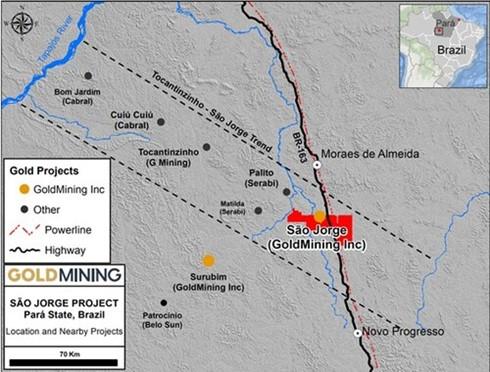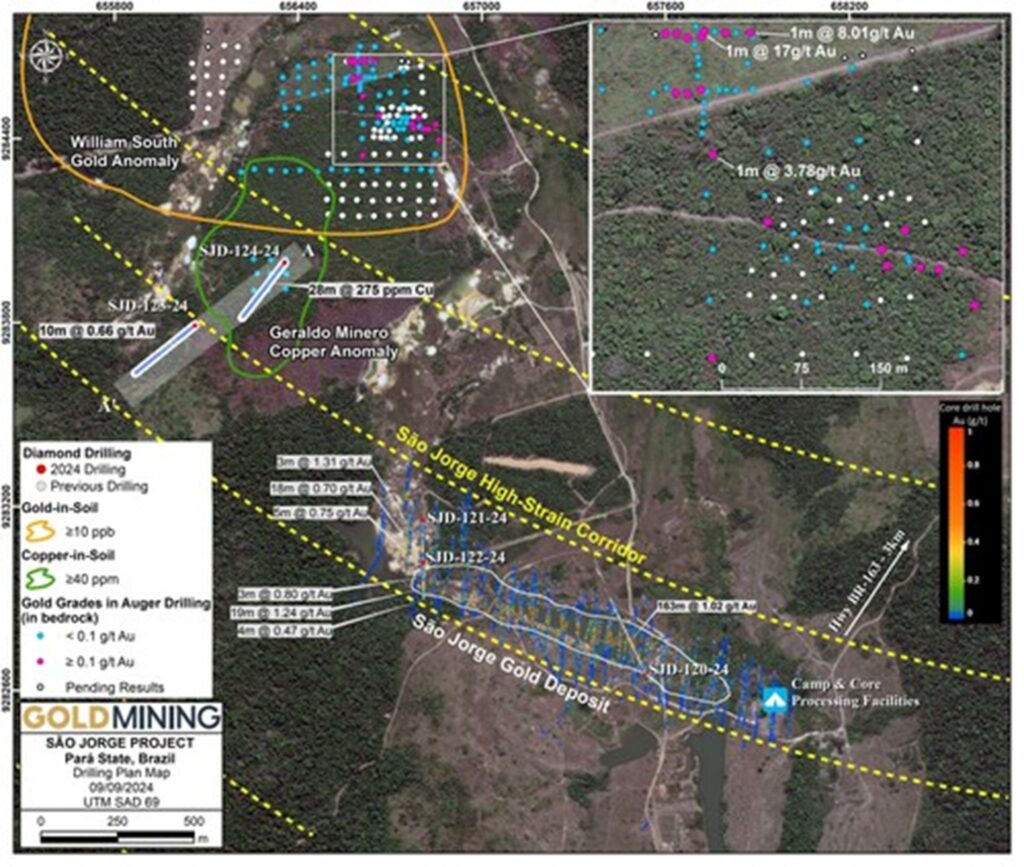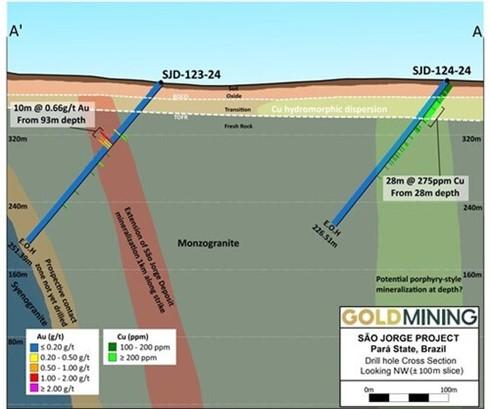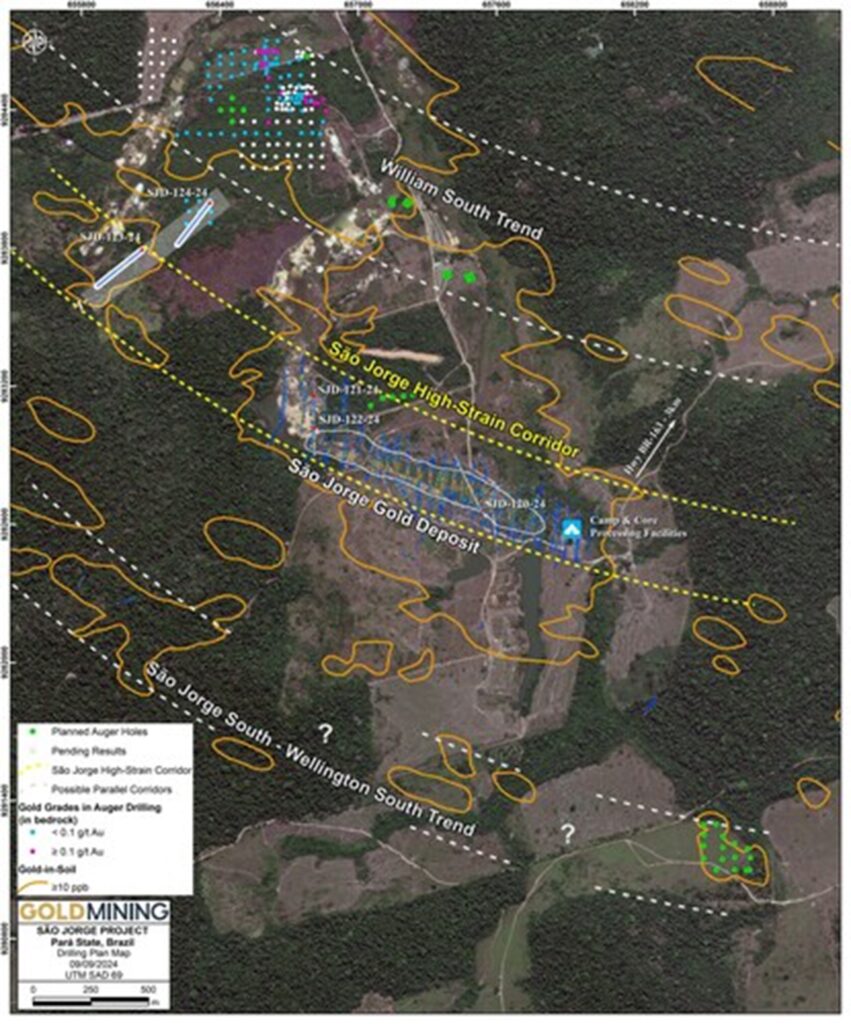
GoldMining Discovers Gold and Copper Mineralization in Drilling 1 km from the São Jorge Deposit, Brazil

GoldMining Inc. (TSX: GOLD) (NYSE American: GLDG) is pleased to report final drill assay results from the previously announced diamond drilling program, and a progress update for the ongoing auger drilling program, at the Company’s 100% owned São Jorge Project in the Tapajós gold district Pará State, Brazil.
Highlights include:
- The two most recent diamond drill holes successfully identified new gold and copper mineralization approximately 1 kilometre northwest of the São Jorge gold deposit in areas that had no previous drilling. Assay results include:
- Drill hole SJD-123-24:
- 10 m at 0.66 grams per tonne gold from 93 metres depth, including:
- 2 m at 1.65 g/t Au from 93 m depth.
- 10 m at 0.66 grams per tonne gold from 93 metres depth, including:
- Drill hole SJD-124-24:
- 28 m at 275 ppm (0.0275%) copper from 28 m depth.
- Drill hole SJD-123-24:
- The ongoing shallow auger drilling program has returned very encouraging indications of new zones of primary gold mineralization at the William South target located approximately 2 km north of the Deposit. Several auger drill holes delivered high-grade intercepts within the top of weathered bedrock, directly underlying large high-tenor surface soil anomalies. Highlight drill intercepts include:
- 1 m at 17.14 g/t Au from 12 m depth
- 1 m at 8.01 g/t Au from 6 m depth
- 1 m at 3.78 g/t Au from 10 m depth
Alastair Still, Chief Executive Officer of GoldMining, commented: “The exploration program at São Jorge completed to date has significantly advanced our geological knowledge in the São Jorge district, including better defining the high-grade core of the São Jorge deposit. The recent step-out core drilling program has identified mineralization approximately 1 km away from the existing mineral resource in an area with no previous drilling. In addition, our team has assembled exciting evidence for potential additional corridors of mineralization on the regional scale property, which were diligently identified via gold-in-soil sampling and now have been confirmed through auger drilling to include a bedrock source containing high-grade gold.”
Tim Smith, Vice President of Exploration of GoldMining, commented: “To complement the encouraging gold mineralization intersected in step-out core and auger drilling, drill hole SJD-124-24 intersected a broad zone of strongly anomalous copper which is encouraging as the Tapajos district is known to contain porphyry-style copper +/- gold mineralization. Further, gold mineralization intersected in SJD-123-24 is consistent with our thesis of an extensive high-strain corridor that could host additional gold mineralization northwest and southeast along strike of the Deposit as a component of a regional scale gold-bearing mineral system.”
São Jorge Drill Program Overview
The Company commenced drilling at São Jorge in May 2024 (see news release dated May 29, 2024). The objectives of the program included confirmatory drilling within and near the margins of the existing São Jorge gold deposit, as well as exploratory drilling of identified gold targets within 1-2 km of known mineralization in areas with no previous drilling.
The diamond core drilling component of the program consisted of 1,077 m over five holes, and the ongoing 3,000 m auger drilling program is approximately two thirds complete, with assays received from approximately one third of the projected program. Assay results for the latest two diamond drill holes (SJD-123-24 and SJD-124-24) have been received, which combined with the previously released holes, SJD-120-24 to SJD-122-24 (see news releases dated June 18 and July 9, 2024), successfully concludes the current phase of diamond core drilling planned for São Jorge. The latest holes have identified new gold and copper mineralization approximately 1 km northwest of the existing deposit in an area that had not been previously drilled.
Ongoing auger drilling, focused in an area located approximately 2 km north of the São Jorge deposit to follow up on the large high tenor ‘William South’ gold-in-soil anomaly, has returned very encouraging indications of primary gold mineralization in bedrock which highlights that the large, regional-scale property has potential to host additional corridors of mineralization that can be further tested by core drilling.
São Jorge lies within the active and rapidly developing Tapajós Gold District (see Figure 1), which is estimated to have produced over 20 million ounces of gold historically from artisanal mining of surface deposits, according to the Brazil National Mining Agency. The Tapajós is home to Serabi Gold Plc.’s producing high-grade underground Palito Mine and G Mining Ventures Corp.’s (“G Mining”) brand new Tocantinzinho Gold Mine, which recently declared commercial production (see G Mining news release September 3, 2024).
São Jorge is located immediately adjacent to paved Hwy BR-163 and a new 138 kV powerline corridor, which ties into the district electrical grid recently constructed for the Tocantinzinho Gold Mine. Exploration activities at São Jorge are operated from a permanent camp near the existing Deposit and just 3 km from the highway.
Diamond Core Drilling Program
Highlights of the confirmatory component of the drilling program included drill holes SJD-120-24 (see news release dated June 18, 2024) with an interval of 163 m at 1.02 g/t Au, and SJD-121-24 and SJD-122-24 (see news release dated July 9, 2024) with intervals of 18 m at 0.70 g/t Au and 19 m at 1.24 g/t Au respectively.
SJD-123-24 and SJD-124-24 – new drilling reported in this release – comprised step-out drilling located approximately 1 km to the northwest of the Deposit, testing coincident geochemical and geophysical anomalies interpreted to form an extension of the São Jorge high-strain corridor (see Figure 2). SJD-123-24 and SJD-124-24 tested strong and broad gold- and copper-in-soil surface anomalies, respectively. See Tables 1 and 2 for further information regarding the diamond core drilling.
Gold mineralization encountered in SJD-123-24 is similar in style to that in the São Jorge deposit, comprising fracture-controlled sulphide ± quartz veins, with the sulphides consisting of dominant pyrite with lesser chalcopyrite. This helps support our geological model that gold mineralization may extend along a broad high-strain corridor co-incident locally with a contact between monzogranite and syenogranite The sheared contact between monzogranite and syenogranite, which at the Deposit forms the southern boundary of the São Jorge high-strain corridor, was not intersected in the shallow depth drilled in SJD-123-24, thus follow-up drilling is warranted both across and along strike (see Figure 3 for a cross-section of SJD-123-24 and SJD-124-24).
The elevated copper encountered in SJD-124-24 is interpreted as a possible hydromorphic dispersion layer in saprolite, see Figure 3, formed from the in situ weathering of granitoid rock and the redistribution of mobile metals by ground water. It may form a horizontal blanket-shaped plume of elevated copper, concentrated between the base of complete oxidation (“BOCO”) and top of fresh rock (“TOFR”), which is the typical location for hydromorphic mobilization of soluble metals in a lateritic weathering profile such as in the Tapajós district of the Brazilian Craton. The strongly anomalous Cu zone in SJD-124-24 contains approximately 20 times the typical background of copper levels normally found in granitoid rocks, and the location, continuity and tenor of the anomalous copper values may indicate an underlying bedrock source of copper mineralization in close proximity. Deeper sections of SJD-124-24 intersected thin discrete sulphide bearing veins with dominant pyrite and chalcopyrite, thus confirming a possible source of the elevated copper in bedrock. Hydromorphic dispersion halos may extend for 10s to 100s of meters from the source bedrock mineralization, therefore follow-up drilling is warranted to further explore and confirm the potential source, tenor and style of copper mineralization responsible for the broad halo of copper enrichment in the weathering profile.
Auger Geochemical Drilling Program
A power auger drilling program comprising an initial program of 3,000 meters for approximately 200 holes is underway at the Project. The auger program is initially targeting the high priority ‘William South’ area located approximately 2 km north of the São Jorge deposit. William South comprises a broad high-tenor zone of anomalous gold-in-soil (see Figures 2 and 4), measuring approximately 2 km x 2 km with soil assays peaking at 2,163 ppb Au (2.163 g/t Au).
To date assays have been received for 101 holes completed at the William South target. From the initial drill results, approximately 25% of all holes have returned assay results greater than 100 ppb (0.1 g/t) Au, confirming the presence of gold mineralization in weathered bedrock. Note that background gold values in both residual weathered bedrock and overlying transported soils, is expected to range from nil to 1-2 ppb Au, thus values of greater than 10 -25 ppb Au are considered to be ‘elevated’ and greater than 100 ppb Au to be ‘highly anomalous’.
The auger drilling comprises a powered 20 centimetre diameter rotary drill head capable of penetrating to 15-20 m depth. A geologist or technician supervises the drilling to log the drill cuttings and distinguish transported overburden from in situ weathered bedrock. Sampling is conducted on 1 m intervals with assaying to 5 ppb Au detection. The drill method is open-hole, therefore contamination and/or dilution of precious metal grades by material from higher in the hole is possible. However, the low detection limit assay results, coupled with interpretation of the geological profile, provides a quick, cheap and effective direct mapping of the presence of gold mineralization in the uppermost portion of the residual weathered bedrock profile. This information can be used to guide follow-up exploration drilling using larger equipment such as reverse circulation (RC) or diamond core drilling. The auger drilling assay results received to date are illustrated in Figure 2, and details are provided in Tables 3 & 4.
Auger drilling at William South has to date returned very encouraging indications of primary gold mineralization in bedrock, which confirms an in situ source of the gold-in-soil anomaly and encourages more widespread application of auger drilling – a cheap and rapid sub-surface geochemical test – across other gold-in-soil anomalies within the Project. Furthermore, the confirmation of a bedrock gold source beneath the William South soil anomaly suggests that the large, regional-scale Project has potential to host additional corridors of mineralization that can be further tested by deeper RC or core drilling methods to define new bedrock gold discoveries. Several additional target areas are planned for auger drill testing over the coming months, see Figure 4.
For additional information regarding the São Jorge Project, including existing resource estimates and historical work at the project, please refer to the technical report titled “São Jorge Gold Project, Pará State, Brazil: Independent Technical Report on Mineral Resources”, prepared for the Company and dated effective May 31, 2021, which is available under the Company’s profile at www.sedarplus.ca.
Table 1 – São Jorge assay intercepts from the 2024 diamond core drilling program, received as of September 9, 2024.
| Hole Number | Interval From
(m) |
Interval To
(m) |
Core
Length1 (m) |
Au Grade
(g/t) |
Cu Grade
(ppm) |
| SJD-120-24 | 44.00 | 207.00 | 163.00 | 1.02 | – |
| SJD-120-24 | 44.00 | 64.00 | 20.00 | 1.37 | – |
| Including | 45.00 | 50.00 | 5.00 | 2.82 | – |
| Including | 45.00 | 46.00 | 1.00 | 7.25 | – |
| SJD-120-24 | 69.00 | 70.00 | 1.00 | 3.03 | – |
| SJD-120-24 | 74.00 | 75.00 | 1.00 | 5.05 | – |
| SJD-120-24 | 95.00 | 132.00 | 37.00 | 2.26 | – |
| Including | 97.00 | 98.00 | 1.00 | 11.47 | – |
| Including | 102.00 | 104.00 | 2.00 | 12.22 | – |
| SJD-120-24 | 148.00 | 159.00 | 11.00 | 1.00 | – |
| Including | 152.00 | 155.00 | 3.00 | 2.31 | – |
| SJD-120-24 | 166.00 | 179.00 | 13.00 | 1.35 | – |
| SJD-120-24 | 195.0 | 207.0 | 12.00 | 1.15 | – |
| including | 201.00 | 206.00 | 5.00 | 2.24 | – |
| Including | 205.00 | 206.00 | 1.00 | 7.29 | – |
| SJD-120-24 | 249.00 | 250.00 | 1.00 | 1.07 | – |
| SJD-120-24 | 259.00 | 260.00 | 1.00 | 1.27 | – |
| SJD-120-24 | 265.00 | 266.00 | 1.00 | 3.74 | – |
| SJD-121-24 | 49.00 | 52.00 | 3.00 | 1.31 | – |
| SJD-121-24 | 86.00 | 104.00 | 18.00 | 0.70 | – |
| Including | 88.00 | 96.00 | 8.00 | 1.14 | – |
| SJD-121-24 | 191.00 | 196.00 | 5.00 | 0.75 | – |
| SJD-122-24 | 32.00 | 35.00 | 3.00 | 0.80 | – |
| SJD-122-24 | 61.00 | 80.00 | 19.00 | 1.24 | – |
| Including | 68.00 | 75.00 | 7.00 | 2.98 | – |
| Including | 72.00 | 73.00 | 1.00 | 15.67 | – |
| SJD-122-24 | 110.00 | 114.00 | 4.00 | 0.47 | – |
| SJD-123-24 | 93.00 | 103.00 | 10.00 | 0.66 | – |
| Including | 93.00 | 95.00 | 2.00 | 1.65 | – |
| SJD-124-24 | 28.00 | 56.00 | 28.00 | – | 275 |
| Notes: | |
| 1. | True widths are estimated to be approximately 66% of downhole length, assuming primarily steeply dipping vein-hosted mineralization. |
Table 2 – São Jorge 2024 diamond core drill hole collar location coordinates.
| Hole
Number |
Easting
Metres (UTM Zone 21S) |
Northing
Metres (UTM Zone 21S) |
Elevation
(m above sea level) |
Depth
(m) |
Azimuth
(Degrees) |
Dip
(Degrees) |
Status |
| SJD 120-24 | 657535 | 9282655 | 209.45 | 271.84 | 335 | -50 | All assays
received |
| SJD 121-24 | 656807 | 9283159 | 211.50 | 200.34 | 180 | -50 | All assays
received |
| SJD 122-24 | 656810 | 9283020 | 214.90 | 126.43 | 180 | -50 | All assays
received |
| SJD 123-24 | 656065 | 9283800 | 203.10 | 251.39 | 230 | -50 | All assays
received |
| SJD 124-24 | 656360 | 9284004 | 223.29 | 226.51 | 215 | -50 | All assays
received |
Table 3 – São Jorge bedrock assay intercepts from the 2024 auger drilling program, received as of September 9, 2024
| Hole Number | Interval
From (m) |
Interval
To (m) |
Sample
Length1 (m) |
Au Grade
(g/t) |
| SJTRD-047-24 to SJTRD-053-24 | No Significant Result | |||
| SJTRD-054-24 | 9.00 | 10.00 | 1.00 | 0.22 |
| SJTRD-055-24 | 10.00 | 11.00 | 1.00 | 0.96 |
| SJTRD-056-24 to SJTRD-076-24 | No Significant Result | |||
| SJTRD-077-24 | 7.00 | 9.00 | 1.00 | 3.05 |
| SJTRD-078-24 | No Significant Result | |||
| SJTRD-079-24 | 4.00 | 5.00 | 1.00 | 0.12 |
| SJTRD-080-24 | 5.00 | 6.00 | 1.00 | 0.18 |
| SJTRD-081-24 | 4.00 | 5.00 | 1.00 | 0.32 |
| SJTRD-082-24 | 8.00 | 9.00 | 1.00 | 2.03 |
| And | 12.00 | 13.00 | 1.00 | 17.14 |
| SJTRD-083-24 | No Significant Result | |||
| SJTRD-084-24 | 17.00 | 18.00 | 1.00 | 0.92 |
| SJTRD-085-24 | No Significant Result | |||
| SJTRD-086-24 | 6.00 | 7.00 | 1.00 | 8.01 |
| SJTRD-087-24 to SJTRD-089-24 | No Significant Result | |||
| SJTRD-090-24 | 9.00 | 10.00 | 1.00 | 0.83 |
| SJTRD-091-24 | 9.00 | 11.00 | 2.00 | 1.47 |
| SJTRD-092-24 to SJTRD-095-24 | No Significant Result | |||
| SJTRD-096-24 | 6.00 | 7.00 | 1.00 | 0.28 |
| SJTRD-097-24 | No Significant Result | |||
| SJTRD-098-24 | 6.00 | 8.00 | 2.00 | 0.38 |
| SJTRD-099-24 to SJTRD-107-24 | No Significant Result | |||
| SJTRD-108-24 | 10.00 | 11.00 | 1.00 | 0.10 |
| SJTRD-109-24 | 9.00 | 10.00 | 1.00 | 0.11 |
| SJTRD-110-24 | 7.00 | 8.00 | 1.00 | 0.21 |
| SJTRD-111-24 | No Significant Result | |||
| SJTRD-112-24 | 5.00 | 6.00 | 1.00 | 0.19 |
| SJTRD-113-24 | 10.00 | 11.00 | 1.00 | 0.17 |
| SJTRD-114-24 to SJTRD-120-24 | No Significant Result | |||
| SJTRD-121-24 | 8.00 | 9.00 | 1.00 | 0.11 |
| SJTRD-122-24 to SJTRD-123-24 | No Significant Result | |||
| SJTRD-124-24 | 9.00 | 11.00 | 2.00 | 2.06 |
| Including | 10.00 | 11.00 | 1.00 | 3.78 |
| SJTRD-125-24 to SJTRD-127-24 | No Significant Result | |||
| SJTRD-128-24 | 13.00 | 14.00 | 1.00 | 0.78 |
| SJTRD-129-24 to SJTRD-142-24 | No Significant Result | |||
| Notes: | |
| 1. | True widths are unknown given the vertical hole angle and limited depth of drill penetration. |
Table 4 – São Jorge 2024 auger drill hole collar location coordinates.1
| Hole Number | Easting
Metres (UTM Zone 21S) |
Northing
Metres (UTM Zone 21S) |
Elevation
(m above sea level) |
Depth
(m) |
Status |
| SJTRD-047-24 | 656598 | 9284613 | 210 | 20 | All assays received |
| SJTRD-048-24 | 656712 | 9284447 | 211 | 15 | All assays received |
| SJTRD-049-24 | 656709 | 9284505 | 214 | 14 | All assays received |
| SJTRD-052-24 | 656701 | 9284550 | 215 | 14 | All assays received |
| SJTRD-051-24 | 656651 | 9284700 | 215 | 8 | All assays received |
| SJTRD-050-24 | 656650 | 9284650 | 219 | 11 | All assays received |
| SJTRD-055-24 | 656650 | 9284600 | 218 | 13 | All assays received |
| SJTRD-054-24 | 656601 | 9284600 | 217 | 12 | All assays received |
| SJTRD-053-24 | 656601 | 9284650 | 221 | 10 | All assays received |
| SJTRD-056-24 | 656603 | 9284701 | 215 | 7 | All assays received |
| SJTRD-057-24 | 656401 | 9284500 | 219 | 14 | All assays received |
| SJTRD-058-24 | 656402 | 9284550 | 222 | 12 | All assays received |
| SJTRD-059-24 | 656402 | 9284600 | 223 | 11 | All assays received |
| SJTRD-060-24 | 656401 | 9284635 | 219 | 10 | All assays received |
| SJTRD-061-24 | 656350 | 9284600 | 218 | 9 | All assays received |
| SJTRD-062-24 | 656351 | 9284550 | 220 | 13 | All assays received |
| SJTRD-063-24 | 656357 | 9284500 | 207 | 14 | All assays received |
| SJTRD-064-24 | 656361 | 9284445 | 225 | 13 | All assays received |
| SJTRD-065-24 | 656602 | 9284559 | 216 | 14 | All assays received |
| SJTRD-066-24 | 656603 | 9284568 | 226 | 13 | All assays received |
| SJTRD-067-24 | 656603 | 9284578 | 201 | 14 | All assays received |
| SJTRD-068-24 | 656604 | 9284588 | 209 | 13 | All assays received |
| SJTRD-069-24 | 656607 | 9284598 | 230 | 14 | All assays received |
| SJTRD-070-24 | 656618 | 9284600 | 203 | 12 | All assays received |
| SJTRD-071-24 | 656599 | 9284624 | 205 | 16 | All assays received |
| SJTRD-072-24 | 656598 | 9284631 | 207 | 18 | All assays received |
| SJTRD-073-24 | 656595 | 9284643 | 206 | 18 | All assays received |
| SJTRD-074-24 | 656596 | 9284660 | 206 | 16 | All assays received |
| SJTRD-075-24 | 656596 | 9284676 | 204 | 18 | All assays received |
| SJTRD-076-24 | 656599 | 9284652 | 205 | 18 | All assays received |
| SJTRD-077-24 | 656801 | 9284637 | 212 | 15 | All assays received |
| SJTRD-078-24 | 656558 | 9284652 | 205 | 18 | All assays received |
| SJTRD-079-24 | 656567 | 9284653 | 206 | 18 | All assays received |
| SJTRD-080-24 | 656578 | 9284653 | 205 | 18 | All assays received |
| SJTRD-081-24 | 656588 | 9284649 | 205 | 18 | All assays received |
| SJTRD-082-24 | 656604 | 9284655 | 221 | 16 | All assays received |
| SJTRD-083-24 | 656614 | 9284655 | 221 | 18 | All assays received |
| SJTRD-084-24 | 656624 | 9284654 | 221 | 18 | All assays received |
| SJTRD-085-24 | 656634 | 9284654 | 220 | 18 | All assays received |
| SJTRD-086-24 | 656648 | 9284654 | 220 | 18 | All assays received |
| SJTRD-087-24 | 656645 | 9284625 | 209 | 15 | All assays received |
| SJTRD-088-24 | 656625 | 9284600 | 208 | 15 | All assays received |
| SJTRD-089-24 | 656634 | 9284599 | 208 | 15 | All assays received |
| SJTRD-090-24 | 656588 | 9284596 | 211 | 15 | All assays received |
| SJTRD-091-24 | 656577 | 9284597 | 212 | 15 | All assays received |
| SJTRD-092-24 | 656568 | 9284602 | 223 | 15 | All assays received |
| SJTRD-093-24 | 656556 | 9284597 | 209 | 15 | All assays received |
| SJTRD-094-24 | 656711 | 9284454 | 218 | 15 | All assays received |
| SJTRD-095-24 | 656733 | 9284452 | 219 | 15 | All assays received |
| SJTRD-096-24 | 656772 | 9284449 | 220 | 15 | All assays received |
| SJTRD-097-24 | 656797 | 9284441 | 214 | 15 | All assays received |
| SJTRD-098-24 | 656826 | 9284430 | 209 | 15 | All assays received |
| SJTRD-099-24 | 656744 | 9284621 | 196 | 15 | All assays received |
| SJTRD-100-24 | 656702 | 9284607 | 203 | 15 | All assays received |
| SJTRD-101-24 | 656506 | 9284656 | 209 | 15 | All assays received |
| SJTRD-102-24 | 656451 | 9284645 | 210 | 15 | All assays received |
| SJTRD-103-24 | 656452 | 9284600 | 212 | 15 | All assays received |
| SJTRD-104-24 | 656507 | 9284600 | 210 | 15 | All assays received |
| SJTRD-105-24 | 656553 | 9284579 | 236 | 15 | All assays received |
| SJTRD-106-24 | 656496 | 9284557 | 235 | 15 | All assays received |
| SJTRD-107-24 | 656451 | 9284545 | 223 | 15 | All assays received |
| SJTRD-108-24 | 656860 | 9284396 | 220 | 15 | All assays received |
| SJTRD-109-24 | 656849 | 9284447 | 211 | 15 | All assays received |
| SJTRD-110-24 | 656808 | 9284432 | 215 | 15 | All assays received |
| SJTRD-111-24 | 656798 | 9284438 | 218 | 15 | All assays received |
| SJTRD-112-24 | 656794 | 9284467 | 231 | 15 | All assays received |
| SJTRD-113-24 | 656777 | 9284434 | 212 | 15 | All assays received |
| SJTRD-114-24 | 656744 | 9284432 | 221 | 15 | All assays received |
| SJTRD-115-24 | 656757 | 9284469 | 219 | 15 | All assays received |
| SJTRD-116-24 | 656741 | 9284469 | 204 | 15 | All assays received |
| SJTRD-117-24 | 656727 | 9284431 | 218 | 15 | All assays received |
| SJTRD-118-24 | 656682 | 9284440 | 214 | 15 | All assays received |
| SJTRD-119-24 | 656689 | 9284464 | 213 | 15 | All assays received |
| SJTRD-120-24 | 656660 | 9284452 | 208 | 15 | All assays received |
| SJTRD-121-24 | 656664 | 9284475 | 206 | 15 | All assays received |
| SJTRD-122-24 | 656661 | 9284500 | 230 | 15 | All assays received |
| SJTRD-123-24 | 656665 | 9284541 | 206 | 15 | All assays received |
| SJTRD-124-24 | 656612 | 9284539 | 210 | 15 | All assays received |
| SJTRD-125-24 | 656606 | 9284501 | 213 | 15 | All assays received |
| SJTRD-126-24 | 656612 | 9284449 | 218 | 15 | All assays received |
| SJTRD-127-24 | 656609 | 9284401 | 227 | 15 | All assays received |
| SJTRD-128-24 | 656611 | 9284346 | 213 | 15 | All assays received |
| SJTRD-129-24 | 656606 | 9284296 | 219 | 15 | All assays received |
| SJTRD-130-24 | 656558 | 9284298 | 234 | 15 | All assays received |
| SJTRD-131-24 | 656510 | 9284301 | 229 | 15 | All assays received |
| SJTRD-132-24 | 656463 | 9284291 | 219 | 15 | All assays received |
| SJTRD-133-24 | 656406 | 9284297 | 223 | 15 | All assays received |
| SJTRD-134-24 | 656359 | 9284294 | 224 | 15 | All assays received |
| SJTRD-135-24 | 656311 | 9284297 | 215 | 15 | All assays received |
| SJTRD-136-24 | 656257 | 9284301 | 265 | 15 | All assays received |
| SJTRD-137-24 | 656214 | 9284291 | 216 | 15 | All assays received |
| SJTRD-138-24 | 656659 | 9284298 | 249 | 15 | All assays received |
| SJTRD-139-24 | 656754 | 9284300 | 220 | 15 | All assays received |
| SJTRD-140-24 | 656802 | 9284300 | 208 | 15 | All assays received |
| SJTRD-141-24 | 656835 | 9284295 | 194 | 15 | All assays received |
| SJTRD-142-24 | 656848 | 9284349 | 217 | 12 | All assays received |
| Notes: | |
| 1. | All holes are collared at a vertical hole angle. |
Qualified Person
Paulo Pereira, P. Geo., President of GoldMining, has supervised the preparation of, and verified and approved, the scientific and technical information herein this news release. Mr. Pereira is a Qualified Person as defined in National Instrument 43-101 – Standards of Disclosure for Mineral Projects.
Data Verification
For this drill core sampling program, samples were taken from the NQ/HQ core by sawing the drill core in half, with one-half sent to SGS Geosol Laboratórios Ltda. in Brazil for assaying, and the other half of the core retained at the site for future reference. Sample lengths downhole were uniformly 1.0 m. For the auger drilling program, samples were collected at a 1 m sample interval, with the material being dried, homogenized and split in the field to obtain a 1 kg representative sample which was sent to SGS for analysis. The remaining auger sample material is stored until the lab results are received, and a 1 kg sample duplicate is maintained in the archive.
SGS is a certified commercial laboratory located in Vespasiano, Minas Gerais, Brazil, and is independent of GoldMining. GoldMining has implemented a quality assurance and quality control program for the sampling and analysis of drill core and auger samples, including duplicates, mineralized standards and blank samples for each batch of 100 samples. The gold analyses were completed by FAA505 method (fire-assay with an atomic absorption finish on 50 grams of material). Copper assays were completed by the GE_ICP40Q method (multi-acid digestion with an inductively coupled plasma optical emission spectroscopy finish on 0.25 gram of material).
About GoldMining Inc.
GoldMining Inc. is a public mineral exploration company focused on acquiring and developing gold assets in the Americas. Through its disciplined acquisition strategy, GoldMining now controls a diversified portfolio of resource-stage gold and gold-copper projects in Canada, the U.S.A., Brazil, Colombia, and Peru. The Company also owns approximately 21.5 million shares of Gold Royalty Corp. (NYSE American: GROY), 9.9 million shares of U.S. GoldMining Inc. (Nasdaq: USGO), and 26.7 million shares of NevGold Corp. (TSXV: NAU).

Figure 1 – Tapajós Gold District and location of the São Jorge Project. (CNW Group/GoldMining Inc.)

Figure 2 – São Jorge Project drilling locations, including diamond core holes SJD-123-24, SJD-124-24, previously reported core drill holes, and the ongoing auger drilling. Cross section line ‘A-A’ is indicated for core holes SJD-123-24 & SJD-124-24 – see Figure 4. (CNW Group/GoldMining Inc.)

Figure 3 – São Jorge High-Strain Corridor drill hole cross-section, located approximately 1 km west along strike of the Deposit, showing the location of recently completed SJD-123-24 and SJD-124-24; facing northwest (see section trace on Figure 2). (CNW Group/GoldMining Inc.)

Figure 4 – São Jorge High-Strain Corridor (centre of image) and possible parallel prospective linear trends, defined by gold-in-soil anomalies and supported by geophysical interpretation and further being confirmed by the ongoing auger drilling program. Numerous high tenor gold-in-soil anomalies, occurring within a broader +10 ppb Au anomaly, will be followed up with auger drill grids, which are shown by the green symbols. (CNW Group/GoldMining Inc.)
MORE or "UNCATEGORIZED"
Visionary Copper and Gold Mines Inc. Closes First Tranche of Private Placement Financing
Visionary Copper and Gold Mines Inc. (TSX-V: VCG) (OTCQX: VCGMF) ... READ MORE
Globex Reports First Drill Results from Rouyn-Merger
GLOBEX MINING ENTERPRISES INC. (TSX:GMX) (FRA:G1MN) (OTCQX:GLBX... READ MORE
Revival Gold Provides Update and Latest Results From Drilling at the Mercur Gold Project in Utah
Revival Gold Inc. (TSX-V: RVG) (OTCQX: RVLGF) is pleased to prov... READ MORE
Eloro Resources Intersects Highest Silver Interval to Date at its Iska Iska project, Southern Bolivia with 72 metres grading 294.81 g/t Silver within a broader interval of 180 metres grading 164.74 g/t Silver in Hole DSB-93
Highlights: Eloro’s second phase definition diamond drillin... READ MORE
Aya Gold & Silver Reports High-Grade Silver Results at Zgounder
Aya Gold & Silver Inc. (TSX: AYA; OTCQX: AYASF) is pleased to... READ MORE












